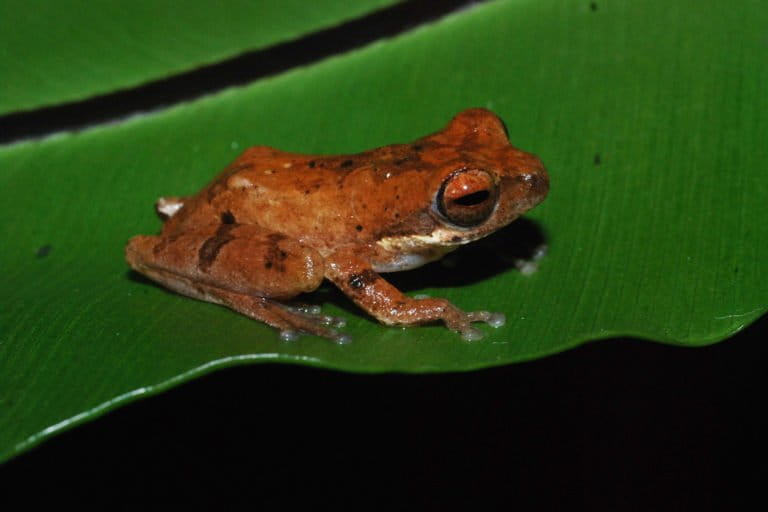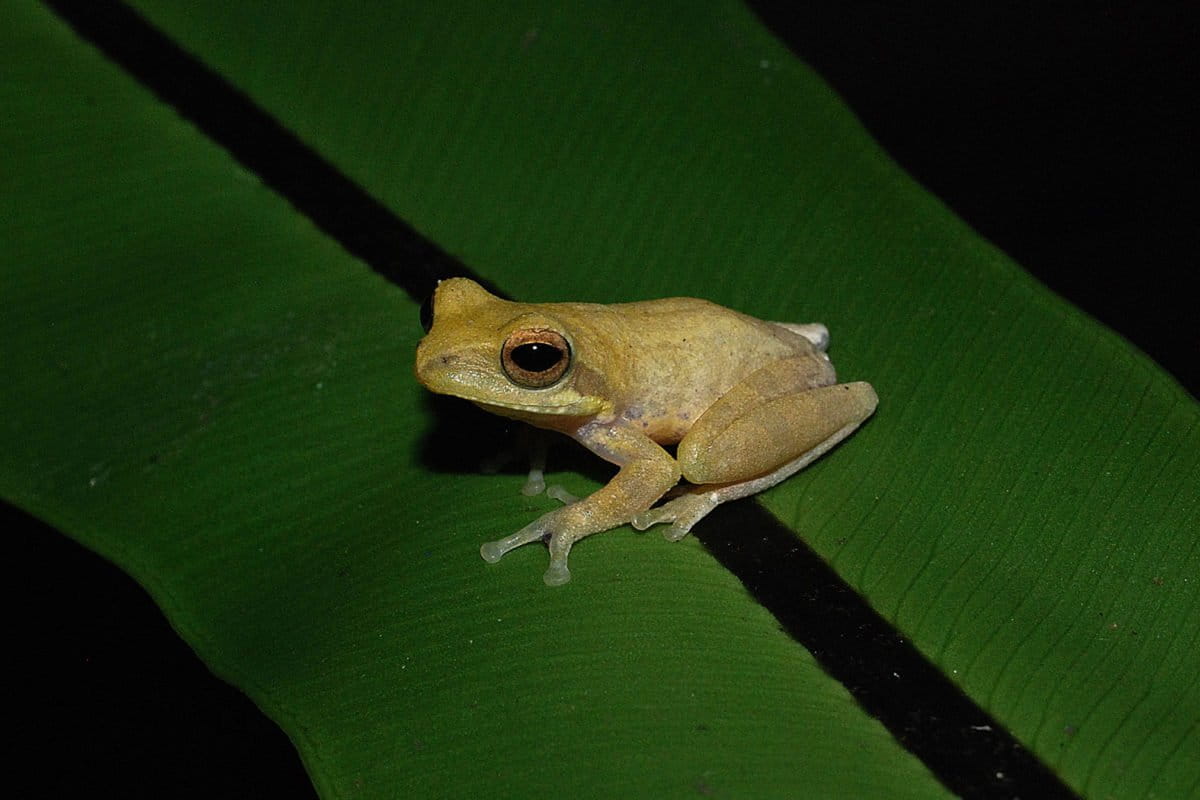- A recent study by researchers from Indonesia and Japan describes the molecular, morphological and acoustic traits of a new frog species from Java: Chirixalus pantaiselatan.
- Scientists recommend further research be conducted to evaluate the breeding traits, distribution and population size to determine IUCN and Indonesian national conservation status of the new species.
- Of the more than 400 frog species in Indonesia, only one amphibian, the bleeding toad (Leptophryne cruentata), is currently listed as an Indonesian protected species.
- Citizen science program Go ARK (Gerakan Observasi Amfibi Reptil Kita) is using the iNaturalist scientific data-sharing platform to contribute to a national database for amphibian and reptile research across the Indonesian archipelago.
On a clear night in 2017, a team of students from Bogor Institute of Agriculture (IPB) set out into a lowland forest on the southwest coast of Java, Indonesia’s most populous island. The students formed part of the Indonesian Herpetological Society’s citizen science program named Gerakan Observasi Amfibi Reptil Kita (“Go ARK”), which helps to compile a national database of reptiles and amphibians across the Indonesian archipelago.
Within the Sancang Nature Reserve, a degraded lowland tropical rainforest covering some 21.6 square kilometers (8.3 square miles), the students came across five frogs perched near a small pond that resembled the tree frogs from the genus Chirixalus.
Following extensive laboratory analysis of these five specimens, the four IPB students along with researchers from Kyoto University in Japan and the Indonesian Institute of Sciences (LIPI) have now published the molecular, morphological and acoustic description of a new frog species: Chirixalus pantaiselatan, named after Java’s South Coast (Pantai Selatan in Indonesian).
The research findings, published in the journal Raffles Bulletin of Zoology, describe the species as a small tree frog that can appear light yellow or light brown depending on whether it’s in sunlight, with an adult male reaching 25.3-28.9 millimeters (1-1.1 inches) in size.

Misbahul Munir, lead author of the study, told Mongabay that although the taxonomic status of the Chirixalus genus is still debated, the agreed identification characteristics within the group provided the basis for scientific identification of the new species.
“The Chirixalus pantaiselatan met the criteria of the genus Chirixalus,” Munir said. “In the study, we describe the horizontal pupils, free and deeply notched tongue, distinct tympanum membrane, opposed fingers, webbed toes and the dilated disks on fingers and toes.”
In addition to these features, acoustic studies of the new species’ advertisement call found that the frog’s “tik-tik-tik-tik-tik-tik” call was distinct from other species already described.
The research team completed genetic tests to determine the relationship of the new species to other close relatives in Indonesia and worldwide, namely the Nongkhor Asian tree frog (Chirixalus nongkhorensis), Trilaksonoi tree frog (C. trilaksonoi), Doria’s Asian tree frog (C. doriae), Dudhwa tree frog (C. dudhwaensis) and the Assam tree frog (C. simus).
“Morphologically (dorsal colour pattern, body size) Chirixalus pantaiselatan is similar to Chirixalus nongkhorensis from Thailand, but genetically is closely related to Chirixalus trilaksonoi, which also comes from Java,” Munir said.

Conservation status
As much of the forest in Java is heavily degraded, or has already been cleared for development, the research team expressed concerns about whether any more of the new species would be found outside the Sancang Nature Reserve.
“The main habitat of the new species is the old secondary lowland forest found in Sancang. This nature reserve is under pressure due to land cover changes, and most of the area has already been logged and turned into open areas and patchy forests,” Munir said. “While Chirixalus pantaiselatan can also be found in the Jayanti Nature Reserve, about 60 km [37 miles] west of Sancang, the Jayanti reserve is in a worse condition than Sancang.”
Any future population surveys would also only be conducted in lowland forests, such as the Sancang and Jayanti reserves, as these species do not occur in highland forests, which constitute the majority of remnant forest cover in Java.
Central to the lack of suitable habitat is what the research team identified as a substantial knowledge gap for the new species and an area of future research: How does C. pantaiselatan reproduce?
Amir Hamidy, a LIPI herpetologist who contributed to the study, told Mongabay the species has the potential to be critically endangered and breeding modes are central to developing habitat and ex-situ conservation plans.
“As the lowland forest cover in Java is so limited, I suspect that we might not find additional populations. If this is the case then the tree frog would be critically endangered,” he said. “Frogs need specific temperatures and habitat for breeding. If these conditions are not widely available then I suspect we will not be able to find other populations in Java.”

Citizen science programs the future of amphibian conservation
Amir points to the success of future C. pantaiselatan research surveys — and amphibian and reptile conservation and awareness in Indonesia — through citizen science programs such as Go ARK.
“The Go ARK program and iNaturalist scientific data sharing platform are a significant resource for the improvement of national scientific databases and data collection across the archipelago,” he said.
During the 2017 Go ARK program, a secondary amphibian species — the dark-eared tree frog (Polypedetes macrotis) — was also discovered in Java, outside its previously restricted distribution.
“[P. macrotis] had previously been found in Sumatra, Kalimantan [Borneo] and on the Malay Peninsula, but this was the first time in Java,” Amir said.
In addition finding new species, the citizen science initiative is promoting popular support for conservation and generating an awareness of Indonesian amphibians and reptiles for students and government bodies.
Amir said that while there are more than 400 frog species in Indonesia, only one amphibian, the bleeding toad (Leptophryne cruentata), is on Indonesia’s list of protected species. Go ARK is a way to connect the Indonesian people to the environment and promote the conservation of amphibians and reptiles.
“[People] do not have to be scientists,” Amir said. “All they have to do is take a photo and there are scientists to analyze the data. It is so important to be able to convince the public and the government to conserve these species and their habitat that are so limited.”
Citation:
Munir, M., Hamidy, A., Kusrini, M. D., Kennedi, U. F., Ridha, M. A., Qayyim, D. I., … Nishikawa, K. (2021). A new species of Chirixalus Boulenger, 1983 (Anura: Rhacophoridae) from the lowland forests of Java. Raffles Bulletin of Zoology, 69(1), 219-234. doi:10.26107/RBZ-2021-0018
Banner image of a Chirixalus pantaiselatan by Misbahul Munir.
